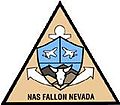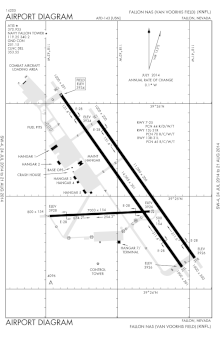Naval Air Station Fallon: Difference between revisions
m fixing "the the" |
→USAF Radar Station: edited and expanded |
||
| Line 52: | Line 52: | ||
Between 1956 and 1975, the [[United States Air Force]] [[Air Defense Command]] 858th Aircraft Control and Warning (later Radar) Squadron operated a General Surveillance Radar station at NAS Fallon. Designated as ADC site SM-156 (later NORAD site Z-156), the squadron operated on the south central section of the station. It initially activated [[AN/MPS-7]] search and [[AN/MPS-14]] height-finder radar sets. An [[AN/FPS-3]] search set briefly saw service in 1959. |
Between 1956 and 1975, the [[United States Air Force]] [[Air Defense Command]] 858th Aircraft Control and Warning (later Radar) Squadron operated a General Surveillance Radar station at NAS Fallon. Designated as ADC site SM-156 (later NORAD site Z-156), the squadron operated on the south central section of the station. It initially activated [[AN/MPS-7]] search and [[AN/MPS-14]] height-finder radar sets. An [[AN/FPS-3]] search set briefly saw service in 1959. |
||
During 1962 Fallon AFS joined the [[Semi Automatic Ground Environment]] (SAGE) system, initially feeding data to DC-16 at [[Stead AFB]], Nevada. After joining, the squadron was re-designated as the [[858th Radar Squadron]] (SAGE) on 1 December 1962. Also in this time frame, the radar site was relocated from the original location in the south central part of the Naval Air Station grounds to the far southwest corner. At the new SAGE radar site, the squadron used an [[AN/FPS-35]] search radar that replaced the AN/MPS-7 set in 1963. In 1964 an [[AN/FPS-6]] height-finder radar was added. |
|||
In addition to the main facility at NAS Fallon, the squadron also operated a remote [[AN/FPS-14]] Gap Filler site: |
In addition to the main facility at NAS Fallon, the squadron also operated a remote [[AN/FPS-14]] Gap Filler site: |
||
* Gabbs, NV (SM-156A): {{Coord|38|46|28|N|118|01|17|W|display=inline|name=SM-156A}} |
* Gabbs, NV (SM-156A): {{Coord|38|46|28|N|118|01|17|W|display=inline|name=SM-156A}} |
||
Around 1965 Fallon became an [[FAA]]/ADC joint-use facility. The AN/MPS-14 radar was retired in 1969. In the early 1970s, the AN/FPS-35 was replaced with an [[AN/FPS-66]]A. The |
Around 1965 Fallon became an [[FAA]]/ADC joint-use facility. The AN/MPS-14 radar was retired in 1969. In the early 1970s, the AN/FPS-35 was replaced with an [[AN/FPS-66]]A. The 858th Radar Squadron (SAGE) was deactivated in June 1975. The FAA retained the AN/FPS-66A search radar, still in-use today and is networked into the [[Joint Surveillance System]] (JSS); the radar tower still is painted with ADC red-and-white checkerboard.<ref> A Handbook of Aerospace Defense Organization 1946 - 1980, by Lloyd H. Cornett and Mildred W. Johnson, Office of History, Aerospace Defense Center, Peterson Air Force Base, Colorado</ref><ref> Winkler, David F. (1997), Searching the skies: the legacy of the United States Cold War defense radar program. Prepared for United States Air Force Headquarters Air Combat Command.</ref> |
||
== References == |
== References == |
||
Revision as of 13:27, 2 February 2011
Naval Air Station Fallon Van Voorhis Field | |||||||||||||||||||
|---|---|---|---|---|---|---|---|---|---|---|---|---|---|---|---|---|---|---|---|
 | |||||||||||||||||||
 Aerial view of NAS Fallon, 1988 | |||||||||||||||||||
| Summary | |||||||||||||||||||
| Airport type | Military: Naval Air Station | ||||||||||||||||||
| Owner | United States Navy | ||||||||||||||||||
| Location | Churchill County, near Fallon, Nevada | ||||||||||||||||||
| Built | June 10, 1944 | ||||||||||||||||||
| In use | Active | ||||||||||||||||||
| Commander | Captain Michael H. Glaser | ||||||||||||||||||
| Elevation AMSL | 3,934 ft / 1,199 m | ||||||||||||||||||
| Coordinates | 39°25′30″N 118°42′10″W / 39.42500°N 118.70278°W | ||||||||||||||||||
| Website | www.cnic.navy.mil/fallon/ | ||||||||||||||||||
| Runways | |||||||||||||||||||
| |||||||||||||||||||
Naval Air Station Fallon or NAS Fallon (IATA: NFL, ICAO: KNFL, FAA LID: NFL) is the United States Navy's premier air-to-air and air-to-ground training facility. It is located southeast of the city of Fallon in western Nevada in the United States. Since 1996, it has been home to the Naval Fighter Weapons School (TOPGUN), and the surrounding area contains 84,000 acres (340 km²) of bombing and electronic warfare ranges. It is also home to the Naval Strike and Air Warfare Center (NSAWC), which includes TOPGUN, the Carrier Airborne Early Warning Weapons School (TOPDOME) and the Navy Rotary Wing Weapons School. Navy SEAL Combat Search and Rescue (CSAR) training also takes place here.
The base is named Van Voorhis Field in honor of Lieutenant Bruce Van Voorhis (1908-1943) who was awarded a posthumous Medal of Honor

History
The airfield at NAS Fallon was originally built in 1942 as part of a defensive network to repel a hypothetical Japanese invasion of the west coast. It was soon taken over by the Navy for training use and has been used as such ever since with the exception of the period of 1946 to 1951, during which it was used by the Bureau of Indian Affairs. On January 1, 1972, the Navy recognized NAS Fallon's importance to naval aviation by upgrading the base to a major command. While NAS Fallon provides training for visiting Carrier air wings, the Strike Fighter Squadron 127 (VFA-127), the "Desert Bogeys", was the air station's only permanently based squadron from October 1987 until it was disestablished on March 23, 1996.
The Navy relocated its Navy Fighter Weapons School, or TOPGUN, from NAS Miramar to NAS Fallon in 1996, following the transfer of NAS Miramar to the Marine Corps and its redesignation as MCAS Miramar. This move resulted in the construction of a new ramp, hangars and academic buildings. The new command, the Naval Strike and Air Warfare Center (NSAWC), was established on July 11, 1996 and was a unification of TOPGUN, Strike University (Strike U), the Naval Strike Warfare Center, and TOPDOME, the Carrier Airborne Early Warning Weapons School. In addition to transferring the NSAWC squadron, a Navy Reserve adversary squadron, Fighter Squadron Composite THIRTEEN (VFC-13), the "Saints," was also permanently relocated from its former base at NAS Miramar to NAS Fallon. As a result, VFC-13 replaced the disestablished VFA-127 in the fighter adversary role.
Associated bombing ranges checker the surrounding Lahontan Valley and Dixie Valley, which is the next valley to the east. Dixie Valley also contains a simulated air defense network, including approximately 20 operational radar installations. Many demilitarized armored vehicles, including some exotics, have been scattered throughout the area, presumably for ambiance. Most of this area is publicly accessible, with the exception of areas immediately surrounding the radar installations.
USAF Radar Station
Between 1956 and 1975, the United States Air Force Air Defense Command 858th Aircraft Control and Warning (later Radar) Squadron operated a General Surveillance Radar station at NAS Fallon. Designated as ADC site SM-156 (later NORAD site Z-156), the squadron operated on the south central section of the station. It initially activated AN/MPS-7 search and AN/MPS-14 height-finder radar sets. An AN/FPS-3 search set briefly saw service in 1959.
During 1962 Fallon AFS joined the Semi Automatic Ground Environment (SAGE) system, initially feeding data to DC-16 at Stead AFB, Nevada. After joining, the squadron was re-designated as the 858th Radar Squadron (SAGE) on 1 December 1962. Also in this time frame, the radar site was relocated from the original location in the south central part of the Naval Air Station grounds to the far southwest corner. At the new SAGE radar site, the squadron used an AN/FPS-35 search radar that replaced the AN/MPS-7 set in 1963. In 1964 an AN/FPS-6 height-finder radar was added.
In addition to the main facility at NAS Fallon, the squadron also operated a remote AN/FPS-14 Gap Filler site:
- Gabbs, NV (SM-156A): 38°46′28″N 118°01′17″W / 38.77444°N 118.02139°W
Around 1965 Fallon became an FAA/ADC joint-use facility. The AN/MPS-14 radar was retired in 1969. In the early 1970s, the AN/FPS-35 was replaced with an AN/FPS-66A. The 858th Radar Squadron (SAGE) was deactivated in June 1975. The FAA retained the AN/FPS-66A search radar, still in-use today and is networked into the Joint Surveillance System (JSS); the radar tower still is painted with ADC red-and-white checkerboard.[3][4]
References
- ^ FAA Airport Form 5010 for NFL PDF, effective 2008-09-25.
- ^ Naval Air Station Fallon, official website
- ^ A Handbook of Aerospace Defense Organization 1946 - 1980, by Lloyd H. Cornett and Mildred W. Johnson, Office of History, Aerospace Defense Center, Peterson Air Force Base, Colorado
- ^ Winkler, David F. (1997), Searching the skies: the legacy of the United States Cold War defense radar program. Prepared for United States Air Force Headquarters Air Combat Command.
External links
- Naval Air Station Fallon at GlobalSecurity.org
- FAA Airport Diagram (PDF), effective May 16, 2024
- FAA Terminal Procedures for NFL, effective May 16, 2024
- Resources for this U.S. military airport:
- FAA airport information for NFL
- AirNav airport information for KNFL
- ASN accident history for NFL
- NOAA/NWS latest weather observations
- SkyVector aeronautical chart for KNFL
